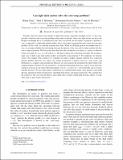Can light dark matter solve the core-cusp problem?
Author(s)
Deng, Heling; Hertzberg, Mark P.; Namjoo, Mohammad Hossein; Masoumi, Ali
DownloadPhysRevD.98.023513.pdf (328.5Kb)
PUBLISHER_POLICY
Publisher Policy
Article is made available in accordance with the publisher's policy and may be subject to US copyright law. Please refer to the publisher's site for terms of use.
Terms of use
Metadata
Show full item recordAbstract
Recently, there has been much interest in light dark matter, especially ultralight axions, as they may provide a solution to the core-cusp problem at the center of galaxies. Since very light bosons can have a de Broglie wavelength that is of astrophysical size, they can smooth out the centers of galaxies to produce a core, as opposed to vanilla dark matter models, and so it has been suggested that this solves the core-cusp problem. In this work, we critically examine this claim. While an ultralight particle will indeed lead to a core, we examine whether the relationship between the density of the core and its radius matches the data over a range of galaxies. We first review data that show the core density of a galaxy ρ[subscript c] varies as a function of the core radius R[subscript c] as ρ[subscript c]∝1/R[subscript c][superscript β] with β≈1. We then compare this to theoretical models. We examine a large class of light scalar dark matter models, governed by some potential V. For simplicity, we take the scalar to be complex with a global U(1) symmetry in order to readily organize solutions by a conserved particle number. However, we expect our central conclusions to persist even for a real scalar, and furthermore, a complex scalar matches the behavior of a real scalar in the nonrelativistic limit which is the standard regime of interest. For any potential V, we find the relationship between ρ[subscript c] and R[subscript c] for ground state solutions is always in one of the following regimes: (i) β≫1, or (ii) β≪1, or (iii) unstable, and so it never matches the data. We also find similar conclusions for virialized dark matter, more general scalar field theories, degenerate fermion dark matter, superfluid dark matter, and general polytropes. We conclude that the solution to the core-cusp problem is more likely due to either complicated baryonic effects or some other type of dark matter interactions.
Date issued
2018-07Department
Massachusetts Institute of Technology. Department of PhysicsJournal
Physical Review D
Publisher
American Physical Society
Citation
Deng, Heling, et al. “Can Light Dark Matter Solve the Core-Cusp Problem?” Physical Review D, vol. 98, no. 2, July 2018. © 2018 American Physical Society
Version: Final published version
ISSN
2470-0010
2470-0029